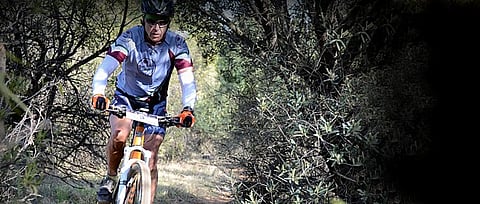Mountain Biking – Part 3 – Keeping the rubber on the rocks
Did you know that the first rubber pneumatic tyre was invented for a cycle, and not a motorised vehicle? Yep that is a fact, although it was actually a tricycle. I am convinced cold climates breed innovators; they spend a lot of time thinking, indoors, out of the frosty cold. A Scotsman, John Boyd Dunlop, a veterinarian by trade, is the recognized inventor of the first practical pneumatic or inflatable tyre. His patent was for a cycle tyre, granted in 1888. Dunlop's rubber-based tyre invention was in response to his son getting headaches while riding his iron-hooped tricycle on rough roads.
By Alexx Zarr
Part two covered Shocks (front forks), Wheels (with Spokes) and Hubs. There are a few last items to finish off to complete a functional Wheel. The first item is Tyres.
The bike used as the base to discuss and compare component is the 2013 Niner RIP RDO, as introduced in Part 1 of this series.
1. Tyres
The Niner wheels are fitted with SchwalbeNobbyNic SnakeskinTL 2.35 tyres, back and front.
That is quite a mouthful, so let me unpack it. Schwalbe is the manufacturer. 'Nic' is the model name, 'SnakeSkin' refers to the trade name for the sidewall construction, 'TL' stands for Tubeless ready and '2.35' is the width in inches. Obviously, the tyrefits a 29 inch sized wheel. The tyres have a rotation direction indicator. Normally the direction of the tread gives an indication of rotation direction.
Tubeless means that the tyre can be used without a tube. A small amount (abut 100ml) of latex-based fluid is inserted into the space the tube would normally occupy. The fluid serves two functions. It seals the contact between the tyre and the rim of the wheel, and fills punctures in the tyre. If the puncture is too large to seal on its own, a plug or a gaiter may be applied.
In South Africa, tubeless tyres with sealant are almost a necessity, to manage punctures caused by glass and thorns.
There are a multitude of brands, tyre sizes, models and tread types. The characteristics to look out for include:
The price, which ranges from about R100 to over a R1,000. The tyre used on the Niner is a top-end product with a top-end price. Higher price does not imply a better tyre
Tyre size should be suitable for the wheel size – 29 inch for 29 inch wheels
Use tubeless, if it your budget can accommodate it. Tubeless types cost more, but save on tubes and reduce the hassle factor
Tyres differ in weight, with some more suited to lightweight riders and racing (about 500g), while others are for heavier riders and more demanding terrain (close to 1kg)
Select a latex sealant. There are some great South African products on the market. It should be replenished regularly, about every three months, or after a large or multiple punctures. Also, if a CO2 canister (bomb) is used to inflate the tyre, the sealant may degrade and need replacing. There are days that I get a dozen or more devil thorns in one tyre, without any need to repair or plug the puncture holes. A little sealant squeezes out, but does not slow one down
Consider whether it suits you to use a narrower tyre at the back and a broader one up front. Check rotation direction when fitting them
Tread patterns are as varied as the stars. The logic I use is as follows. I like soft compound for grip, and therefore I forgo durability. I like a pattern style and density that accommodates most terrain and conditions rather than one condition well and another poorly. However, if you ride mostly in sand, then there are tyres best suited for sand, as there are for gravel, or wet/mud.
Note: As many as there are MTBers, there are views about tyres and which ones do what. Find your own equilibrium. I have three MTBs and have five different tyres fitted to six wheels! I keep experimenting.
The next component dealt with is brakes. While the control mechanism is on the handlebars, the stopping work is done at the wheels.
2. Brakes
The Niner is fitted with SRAM XO brakes with 180mm rotor disk on the back wheel and a 160mm rotor on the front wheel.
Before disc brakes, there were mechanical V-brakes. These are those things that place tension on a cable that pulls two brake pads onto the rim of the wheel. Road bikes still use this type of braking system.
Disk brakes are either hydraulic or mechanical. Different brands generally have three or four levels of products, entry level, a middle and then top end. Different brakes have different 'feels' to the way they function, but most disc brakes are very efficient. Price may be the most influential factor. Disc or rotor size also has an influence on stopping power. Heavier riders require more relative stopping capacity.
Rotor sizes range in size from 140mm through to 203mm. Rotors are constructed from many different alloy materials.
Brake pads, the little disks that create friction on the rotors are made from either metal or resin. The latter may be preferable in dry conditions, but for most of us and for most conditions, metal-base pads should be fine.
The pricing range and other options will be discussed in a subsequent article that covers the components found in the cockpit, the handlebars.

